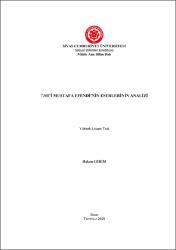| dc.contributor.advisor | Başara, Erol | |
| dc.contributor.author | Cerim, Hakan | |
| dc.date.accessioned | 2020-02-27T06:25:31Z | |
| dc.date.available | 2020-02-27T06:25:31Z | |
| dc.date.issued | 2019 | tr |
| dc.date.submitted | 2019-07-04 | |
| dc.identifier.other | VIII, 145 sayfa | |
| dc.identifier.uri | https://hdl.handle.net/20.500.12418/12277 | |
| dc.description.abstract | Yüzyıllar boyunca Türk müziğine birçok isim katkıda bulunmuştur. Bu
isimlerden biri 18. yüzyılda yaşayan Tab’î Mustafa Efendi’dir. Lâle Devri bestekârı
olan Tab’î, çalgısal ve sözel eserler bestelemiştir. Yaşadığı dönemde divan
edebiyatının kullanılması nedeniyle aruz vezninde küçük ve büyük formlarda eserler
vermiştir.
Bu çalışmada; Tab’î’nin TRT repertuarında bulunan peşrev, saz semâî, şarkı,
beste, ağır semâî, yürük semâî formlarındaki toplam 22 eserinden; “beste(8), ağır
semâî(3), yürük semâî(6)” olmak üzere 17 eseri incelenmiştir. Çalışmanın içeriği üç
bölümden oluşmaktadır. Birinci bölümde, Tab’î’nin hayatı, eserlerinde kullandığı
form-biçim, aruz vezni ve prozodi kuralları hakkında bilgiler verilmiştir. İkinci
bölümde, birinci bölümde verilen bilgilere dayanılarak bestekârın eserleri; makam,
form, usûl ve hece taksimatı bakımından analiz edilmiştir. Hece taksimâtı ve vezin
incelemelerinde tablolardan yararlanılmıştır. Üçüncü bölümde, yapılan analizler
doğrultusunda eserlerdeki saptamalar, sonuç ve öneriler bölümü olarak genel bir
değerlendirme yapılmıştır.
Tab’î’nin incelenen eserlerinde; özgün bir besteleme tarzının olduğu,
bestelerinde geleneğe bağlı kaldığı ve kullandığı form, makam ve prozodi
özelliklerini yansıttığı, prozodi kurallarını birbirleriyle harmanladığı görülmüştür. | tr |
| dc.description.abstract | For centuries, a variety of names have contributed to Turkish music. One of
these names is Tab’î Mustafa Efendi, who lived in the 18th century. Tab’i, a
composer of the Tulip Era, composed instrumental and verbal works. Due to the fact
that the divan literature was used in the period when he lived, Tab’î produced works
in aruz prosody in large forms as well as small forms.
In this study, 17 works of his including Compositions (8), ağır semâî (3),
yürük semâî (6) of a total of 22 works from his works in the forms of peşrev, saz
semâî, songs, composition, ağır semâî, yürük semâî were examined. The contents of
the study consist of three parts. The first chapter makes up the introduction. In the
second chapter, some information related to Tab’î Mustafa Efendi's life and the
forms used in his works, the rules of aruz prosody and prosody is supplied. In the
second chapter, the works of the composer are examined in terms of maqam, form,
divisions and syllable divisions based on the information given in the first chapter.
Tables are utilised in the examinations of syllable divisions and usûl. A
general evaluation of the sections of detections, findings and results in the works has
been made in accordance with the applied analyses.
It has been discovered that the studied works of Tab’î, he had a distinctive
style of composition, that he remained faithful to tradition and reflected the
characteristics of the forms, maqams and prosodies he used in his compositions and
that he blended the rules of the prosody together. | tr |
| dc.language.iso | tur | tr |
| dc.publisher | Sivas Cumhuriyet Üniversitesi Sosyal Bilimler Enstitüsü | tr |
| dc.rights | info:eu-repo/semantics/openAccess | tr |
| dc.subject | Tab’î Mustafa Efendi | tr |
| dc.subject | Form | tr |
| dc.subject | Prozodi | tr |
| dc.subject | Taktî/Durgu | tr |
| dc.subject | Terennüm | tr |
| dc.title | Tab’î Mustafa Efendi’nin Eserlerinin Analizi | tr |
| dc.type | masterThesis | tr |
| dc.contributor.department | Sosyal Bilimler Enstitüsü | tr |
| dc.relation.publicationcategory | Tez | tr |















